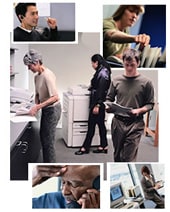Office Environment

Maintaining a healthy office environment requires attention to chemical hazards, equipment and work station design, physical environment (temperature, humidity, light, noise, ventilation, and space), task design, psychological factors (personal interactions, work pace, job control) and sometimes, chemical or other environmental exposures.
A well-designed office allows each employee to work comfortably without needing to over-reach, sit or stand too long, or use awkward postures (correct ergonomic design). Sometimes, equipment or furniture changes are the best solution to allow employees to work comfortably. On other occasions, the equipment may be satisfactory but the task could be redesigned. For example, studies have shown that those working at computers have less discomfort with short, hourly breaks.
Situations in offices that can lead to injury or illness range from physical hazards (such as cords across walkways, leaving low drawers open, objects falling from overhead) to task-related (speed or repetition, duration, job control, etc.), environmental (chemical or biological sources) or design-related hazards (such as nonadjustable furniture or equipment). Job stress that results when the requirements of the job do not match the capabilities or resources of the worker may also result in illness.
NIOSH Resources
NIOSH Publications on Video Display Terminals, Third Edition
NIOSH Publication No. 99-135 (1999)
This publication is a compendium of NIOSH publications and reports on video display terminals (VDTs).
Plain Language About Shiftwork
NIOSH Publication No. 97-145 (1997)
This publication suggests a wide range of strategies that employers and workers can adopt to ease the burdens associated with shiftwork.
Related NIOSH Safety and Health Topics
Alternative Keyboards
NIOSH Publication No. 97-148
This non-technical publication provides basic information about common alternative keyboard designs and their effects on work posture.
Carbonless Copy Paper
Provides additional information about health effects from exposure to carbonless paper.
EMF (Electric and Magnetic Fields)
Provides details about sources of EMF exposure, research that has been done, how EMF’s are measured and several consumer protection links.
Ergonomic and Musculoskeletal Disorders
Provides links to NIOSH Publications and other resources.
Indoor Air Quality
Provides information on Indoor Air Quality and links to NIOSH Publications.
Stress at Work
Provides an overview of Stress at Work and links to other resources.
Noise and Hearing Loss Prevention
Provides information about preventing hearing loss, steps you can take to protect your hearing, links to recent research to reduce hearing loss or study factors that contribute to hearing loss and schedules of related conferences and workshops.
Occupational Violence
Provides more details about NIOSH research on risk factors and prevention strategies.
Womens Health and Safety
Provides information about NIOSH research in industries with a high percentage of women workers (i.e. Clerical, data entry, service work (dry cleaning, grocery), health care workers).
Work Schedules: Shift Work and Long Work Hours
Provides information about health and safety risks associated with shift work and long work hours.
